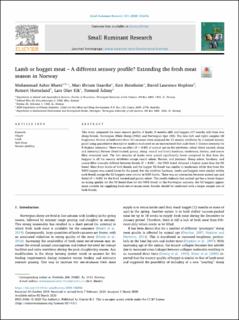| dc.contributor.author | Bhatti, Muhammad Azher | |
| dc.contributor.author | Øvrum Gaarder, Mari | |
| dc.contributor.author | Steinheim, Geir | |
| dc.contributor.author | Hopkins, David Laurence | |
| dc.contributor.author | Horneland, Reinert | |
| dc.contributor.author | Eik, Lars Olav | |
| dc.contributor.author | Ådnøy, Tormod | |
| dc.date.accessioned | 2020-07-09T08:06:47Z | |
| dc.date.available | 2020-07-09T08:06:47Z | |
| dc.date.created | 2020-03-05T10:50:22Z | |
| dc.date.issued | 2020 | |
| dc.identifier.citation | Small Ruminant Research. 2020. Volume 185, April 2020, 106086 | en_US |
| dc.identifier.issn | 0921-4488 | |
| dc.identifier.uri | https://hdl.handle.net/11250/2661537 | |
| dc.description.abstract | This study compared the meat sensory profile of lambs (5 months old) and hoggets (17 months old) from two sheep breeds, Norwegian White Sheep (NWS) and Norwegian Spel (NS). The loin (left and right) samples (M longissimus thoracis et lumborum) from 50 carcasses were analysed for 23 sensory attributes by a trained sensory panel using quantitative descriptive analysis evaluated on an unstructured line scale from 1 (lowest intensity) to 9 (highest intensity). There was an effect (P < 0.05) of animal age on the attributes: odour (fried roasted, sheep and intensity), flavour (fried roasted, gamey, sheep, rancid and liver), hardness, tenderness, fatness, and coarse fibre structural unit. The loin muscles of lambs were scored significantly lower compared to that from the hoggets in all the sensory attributes except rancid odour, flavour, and juiciness. Sheep odour, hardness, and coarse fibre intensity differed between breeds (P < 0.05) – the NWS breed obtained a higher score than the NS breed. Meat from lambs of both breeds and the hogget NS breed was similar in tenderness while that from the NWS hoggets was scored lower by the panel. For the attribute hardness, lambs and hoggets were similar within each breed, except the NS hoggets were similar to NWS lambs. There was an interaction between animal age and breed (P < 0.05) for the fried roasted and gamey odour. The results indicate that animal age has a lower impact on eating quality for the NS breed than for the NWS breed. In the Norwegian scenario, the NS hoggets appear more suitable for supplying fresh out-of-season meat. Results should be confirmed with a larger sample size of both breeds. | en_US |
| dc.language.iso | eng | en_US |
| dc.rights | Attribution-NonCommercial-NoDerivatives 4.0 Internasjonal | * |
| dc.rights.uri | http://creativecommons.org/licenses/by-nc-nd/4.0/deed.no | * |
| dc.title | Lamb or hogget meat – A different sensory profile? Extending the fresh meat season in Norway | en_US |
| dc.type | Peer reviewed | en_US |
| dc.type | Journal article | en_US |
| dc.description.version | publishedVersion | en_US |
| dc.source.pagenumber | 6 | en_US |
| dc.source.volume | 185 | en_US |
| dc.source.journal | Small Ruminant Research | en_US |
| dc.identifier.doi | 10.1016/j.smallrumres.2020.106086 | |
| dc.identifier.cristin | 1799778 | |
| dc.relation.project | Norges forskningsråd: 277044 | en_US |
| dc.relation.project | Regionale forskningsfond Vestlandet: 271952 | en_US |
| dc.relation.project | Nofima AS: 12157 | en_US |
| dc.relation.project | Norges forskningsråd: 262308 | en_US |
| dc.relation.project | Nofima AS: 201702 | en_US |
| cristin.ispublished | true | |
| cristin.fulltext | original | |
| cristin.qualitycode | 1 | |

